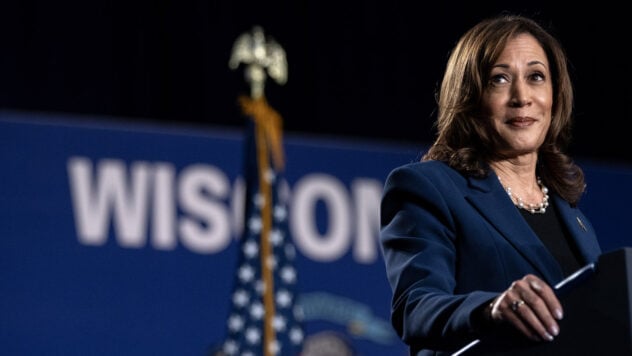
For all the enthusiasm and money Vice President Kamala Harris's campaign is generating for the Democratic Party, its real test will begin soon.
According to Axios, to defeat Donald Trump in the presidential race, Harris will have to overcome the gap with President Biden in approval polls, as well as demonstrate work with working-class voters in key states for Democrats — Pennsylvania, Michigan and Wisconsin.
Harris' fight for key states
Harris, as a California native, will likely have to win all three of those states without the support of Joe Biden, who reminded Pennsylvania voters of his working-class roots when he won the presidency in 2020. < /p>Now watching
Early national polls show Harris's run giving Democrats a boost in a tight race, but the presidential election — this is an interstate competition.
Harris appears to be attracting many younger and minority voters, according to Axios.
— The big question is whether she can maintain Biden's recent gains among older voters and stem Democratic losses among groups such as Hispanic men and whites who didn't attend college — writes the publication.
In a strategy memo released early Wednesday, the Harris campaign says it will succeed. She intends to achieve this, in part by emphasizing women's reproductive rights and contrasting Trump's legal troubles with her history as a prosecutor.
According to the Pew Research Center, Biden's victory over Trump in 2020 was fueled by his performance among whites who did not attend college — group that helped Trump defeat Hillary Clinton in 2016.
As Larry Zeisler, Pennsylvania's communications director, points out, don't expect Harris to match Biden's rural vote share areas of the state.
But he said Harris “will increase turnout and support from African-American voters, diverse voters and young voters”.
Another thing that could help in must-win Pennsylvania: Harris is considering Josh Shapiro, the state's popular Democratic governor, as his vice presidential running mate. Its inclusion on the ballot could change the balance of power.
Sociology and support indicators for Harris
In her campaign, Harris argues that she can increase her support beyond what Biden did in 2020.
— Her net favorability is 19 points higher than Trump's among college-educated white voters and 18 points higher than Trump's among voters over 65, — writes the Harris campaign.
She also claims that about 7% of undecided voters are “black, Hispanic, and people under 30” — voting groups most likely to favor Harris.
At the same time, Axios notes, since Biden left the race on Sunday and Harris entered it, too few polls have been published.
Thus, on Tuesday, Reuters published a national poll, according to which Harris is ahead of Trump by 2 points (44%-42%).
In the same poll taken the previous week, Trump had a 2-point lead, suggesting that the Democratic candidate switch caused Trump to lose ground rather than gain it after the convention.
A new NPR/PBS News/Marist poll shows that Harris' entry into the race has returned the race to what the poll says is a statistical tie.
At the same time, polls in different states are conducted less frequently and do not yet reflect the situation of the last two weeks. The latest data showed Trump ahead in most of the six states where the election is likely to be decided — Arizona, Georgia, Michigan, Nevada, Pennsylvania and Wisconsin.
In a New York Times/Siena College poll conducted before Biden dropped out and Trump was assassinated, Harris did better than Biden and was nearly tied with Trump in Pennsylvania.
In Michigan, according to Real Clear Politics, Trump leads by about 2 points, based on the average of the Trump and Harris polls.
Trump is not far behind
At the same time, the Trump team focused on three Democratic states, with particular attention to Pennsylvania.
His vice presidential running mate, Ohio Sen. J.D. Vance, plans to campaign frequently in Pennsylvania over the next few months, hoping to use his background to attract working-class voters.
At the same time, writes Axios, Harris may try to “neutralize” Vance with his own choice for Vice President.
In addition to Shapiro, Democratic governors such as Roy Cooper (North Carolina) and Andy Beshear (Kentucky) — are vice presidential contenders who are widely popular among moderate Democrats.
Struggle for the US States
Expert Larry Zeisler points out that Harris “and whoever is her nominee will have to work very hard in Pennsylvania”.
— She will have to introduce herself to voters — and she shouldn't allow herself to be portrayed as some left-wing activist from San Francisco, because she's not, — he says.
Three Key States — Pennsylvania, Michigan and Wisconsin — aren't the only places where Harris' nascent coalition will be tested.
Democratic Strategist Tony Kani, deputy director of Biden's 2020 Arizona campaign, says recent Democratic victories have relied on high turnout among young voters and the colored population.
He hopes Harris will win over voters who were unsure about Biden, who leads Trump by several points in Arizona polls.
At the same time, Taron Johnson, a Democratic strategist from Georgia, believes the 2020 Biden-Harris campaign was successful thanks to a broad coalition of voters . In his view, Harris must “reach out a helping hand to the working class”, as well as moderate and party-independent voters, who he believes “are in the balance” from choice.

